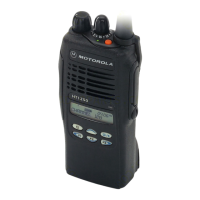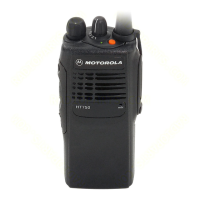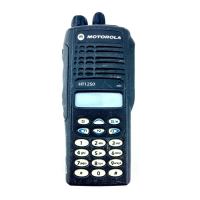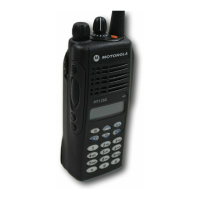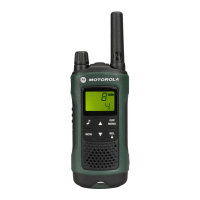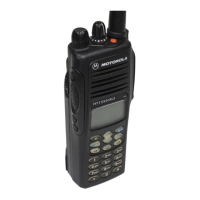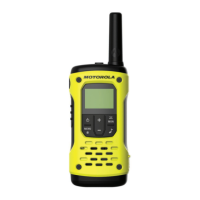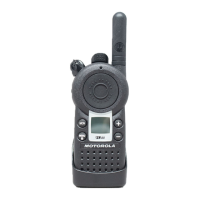7-10 Low Band, 800 MHz, PassPort & 900 MHz Theory of Operation: 800 MHz Receiver
7.7.2 Receiver Back-End
The output of crystal filter FL350 is matched to the input of the dual gate MOSFET IF amplifier
transistor U352 by components L355, R359 and C376. Voltage supply to the IF amplifier is taken
from the receive 5 volts (R5). AGC voltage is applied to the second gate of U352. The IF amplifier
provides a gain of about 11dB. The amplified IF signal is then coupled into U351(pin 3) via L352,
R356 and C365 which provides the matching for the IF amplifier and U351.
The IF signal applied to pin 3 of U351 is amplified, down-converted, filtered, and demodulated, to
produce the recovered audio at pin 27 of U351. This IF IC is electronically programmable, and the
amount of filtering (which is dependent on the radio channel spacing) is controlled by the
microprocessor. Additional filtering, once externally provided by the conventional ceramic filters, is
replaced by internal filters in the IF module (U351).
The IF IC uses a type of direct conversion process, whereby the externally generated second LO
frequency is divided by two in U351 so that it is very close to the first IF frequency. The IF IC (U351)
synthesizes the second LO and phase-locks the VCO to track the first IF frequency. The second LO
is designed to oscillate at twice the first IF frequency because of the divide-by-two function in the IF
IC.
In the absence of an IF signal, the VCO will “search” for a frequency, or its frequency will vary close
to twice the IF frequency. When an IF signal is received, the VCO will lock onto the IF signal. The
second LO/VCO is a Colpitts oscillator built around transistor Q350. The VCO has a varactor diode,
CR350, to adjust the VCO frequency. The control signal for the varactor is derived from a loop filter
consisting of R365, C391, and C392.
The IF IC (U351) also performs several other functions. It provides a received signal-strength
indicator (RSSI) and a squelch output. The RSSI is a dc voltage monitored by the microprocessor,
and used to control the automatic gain control (AGC) circuit in both the front-end and the IF.
The demodulated signal on pin 27 of U351 is also used for squelch control. The signal is routed to
U404 (ASFIC) where squelch signal shaping and detection takes place. The demodulated audio
signal is also routed to U404 for processing before going to the audio amplifier for amplification.
7.7.3 Automatic Gain Control Circuit
The automatic gain control circuit provides automatic gain reduction of both the low noise amplifier in
the receiver front end and the IF amplifier in the receiver backend. This action is necessary to
prevent overloading of the backend IF IC.
The IF automatic gain control circuit provides approximately 50 dB of attenuation range. The signal
strength indicator (RSSI) output of the IF IC produces a voltage that is proportional to the RF level at
the IF input to the IF IC. This voltage is inverted by U350, R351, R353, R352, R354 and C355 and it
determines the RF level at which the backend end AGC is activated as well as the slope of the
voltage at the output of U350 vs. the strength of the incoming RF at the antenna. The inverted output
of U350 is applied to the second gate of the IF amplifier U352 via R355. As the RF signal into the IF
IC increases the following occurs:
• The RSSI voltage increases,
• The output of inverter U350 decreases, and
• The voltage applied to the second gate of the FET is reduced thus reducing the gain of the IF
amplifier.
The output of inverter U350 is also used to control the receiver front end AGC.
The receiver front end automatic gain control circuit provides and additional 20 dB of gain reduction.
The output of the receiver backend inverter U350 is fed into the receiver front end AGC inverter
U302. The components R317, R314, and C318 determine:
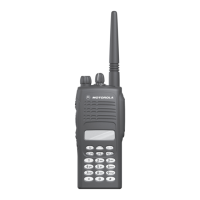
